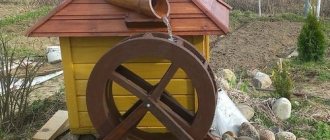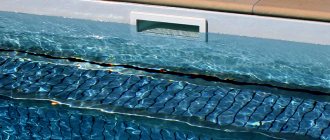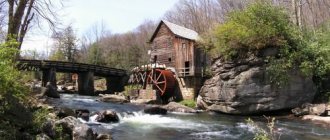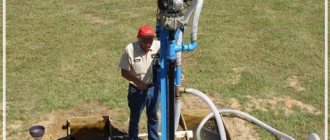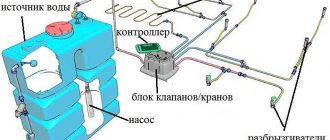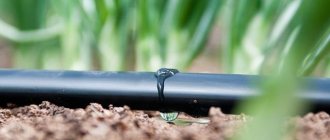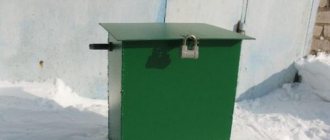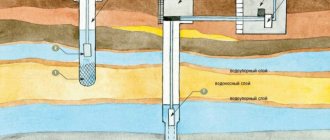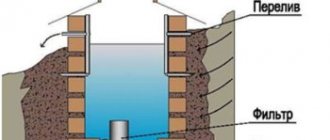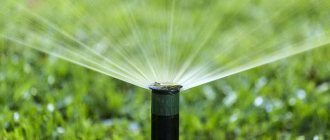Water is needed before a roof over your head is needed. Its availability and quality are the determining factors when purchasing a summer cottage. The water supply system in a country house usually consists of a water source, a water pipeline, a pump or pumping station, wiring in the house, around the site.
The water supply system may also include a water heater, filters, and other water purification equipment. It is advisable to arrange a storage container in a sunny place. It will supply warm water for showering, household needs, regular or drip irrigation.
Water source
If there is no centralized water supply, there are several options.
- Open waters.
- Wells.
- Wells.
The feasibility of the choice is determined only in relation to the specific conditions of the location of the site. It is also necessary to find out what sources of water are used in this area and whether it is suitable for drinking.
The economic component is important. A lake or river will be an eternal supplier; the life of a well or well is limited. The main costs are incurred - unlike the trench to the river - in reaching the aquifers.
The volume of water consumed varies widely. The following indicator can serve as a guide: 1-1.5 m3 per hour covers the peak moments of water collection for the needs of a family of 4 people.
Open waters
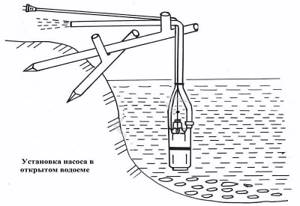
The least expensive way to install water supply in a private house and ensure watering of the area. In addition, such water contains a small amount of hardness salts. The only drawback: it is almost always unsuitable for drinking, as it can be a source of pathogenic microflora.
This is especially true for stagnant ponds and lakes. Taking into account the fact that many in the city do not trust tap water and drink only bottled water, this problem can be completely solved in the country.
Wells
Dug or driven (Abyssinian) wells work only where the aquifer passes at a depth of no more than 25 meters. Driven wells have replaced wells, but if you only have your own hands and are confident in the result, the Abyssinian well is the best option.
A dug well is a complex hydraulic structure. The decision to construct it is made based not only on the presence of a layer of water, but also on the type of soil. Optimal - clay, loam. Peaty, sandy soils are dark water with an odor or quicksand.
Dug wells are divided into shaft and key. The shaft passes to the lens or layer of water, the key is placed on the spring. In modern conditions, the well shaft is reinforced with reinforced concrete rings of the KS grade of various diameters; a wooden frame is no longer used.
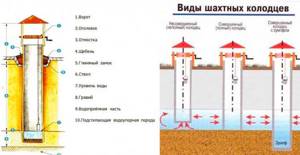
Low water flow is the main risk factor for well water supply. An improperly arranged water intake (there are three types: imperfect, complete, with a sump) is a complete fiasco. The quality of water requires control: a formally made clay castle leads to groundwater entering the well. Its installation can only be entrusted to a professional team.
Well
The most reliable water supply for a private house on earth or a summer cottage. Modern mechanisms and technologies make it possible to arrange it (in the absence of boulders in the ground) in part-time work. There are sand and artesian wells.
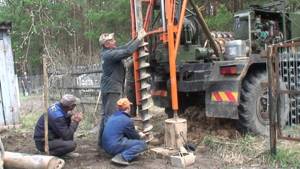
The vast majority are drilled for sand: the extraction of artesian water requires significant investment. In the first case, the source is sandy veins saturated with water, in the second - porous limestones. The sand fraction directly affects the service life of the well: coarse sand, unlike fine, dusty sand, will not sand it.
Water supply from a properly constructed well up to 60 m deep will fully satisfy all needs, regardless of the time of year, for at least 5 years. The water quality is good, but you will have to put up with a high content of calcium and magnesium salts. Their excess is indicated by scale on the walls of the kettle.
Choosing a suitable scheme
When choosing the most convenient and cheapest way to supply drinking water to your cottage, you should take into account the following factors:
- number of residents;
- reliability of power supply in a populated area;
- source of water supply: water supply, well, well or tanker (imported water).
The volume of the storage tank depends on the number of residents (what is a hydraulic accumulator for water supply systems). In this matter, you cannot rely on standards that allocate a minimum of 80 liters per person per day, as no tank will be enough. In practice, a family of 4 people (two children) needs 4 m3 of drinking water for 1 month for cooking and water procedures, subject to economical consumption.
It is not necessary to install a tank if the source of water supply is a well or borehole with a sufficient supply of water (how to make water supply in a private house from a well). Then it can be supplied directly to the house using a surface or deep-well pump.
If the well productivity is low, an intermediate storage tank of 200-500 liters will be needed.
Taking into account all the factors, a suitable autonomous water supply scheme for a private house is selected in accordance with the recommendations:
- If there are frequent power outages, the best option is to place the tank in the attic and fill it with a pump as needed. Supply to sanitary fixtures is carried out by gravity.
- If there is a water supply system that operates at a certain time, or a well with low productivity, a small tank (0.5-1 m3) is placed inside the building. The pressure in the network is created by a pump operating in conjunction with a hydraulic accumulator.
- To replenish the water supply from any source, an underground container at a distance of 5 m from the cottage is suitable. The supply to consumers is also ensured by a pump and a membrane tank.
- The same method is used to organize the supply of water from a well, provided that its depth does not exceed 15 m (how to make a water supply from a well in a country house with your own hands).
- From a well with a sufficient supply of water, water is supplied by a submersible pump, and the pressure in the network is provided by a hydraulic accumulator.
There is also a method of supplying clean groundwater from artesian wells over 50 m deep, from where it flows upward under its own pressure. But drilling such wells is too expensive.
Scheme of autonomous water supply to a house from a well.
Water supply design
Solving the problem of how to make a water supply system in a country house begins with a project. It includes the location of pumping equipment, water pipelines, distribution points, and places to drain water for the winter. Determines the location for filters, heater, and other consumers.
The following information will be required.
- The starting point for the design is the freezing depth of various types of soil. For each region it is indicated in SNiP 2.02.01-83.
- The terrain with further placement of points on the site. This will allow you to install a water supply system with a slope and determine the location for the drain valve when draining the entire system.
- Groundwater occurrence, maximum spring level, possibility of flooding of the area. Important when placing pumping equipment in caissons.
- Site plan with all buildings, already laid communications, large trees to optimize trench routes.
- Points of supply to the house and other consumers.
- Cost of materials for budgeting.
The project should be as complete as possible, but the acquisition and connection of equipment can be done in stages. The electrical part of the project includes power supply to the pumping equipment and installation of additional sockets.
A plan or diagram of a water supply system in a dacha, drawn to scale, will allow you to calculate the length of pipes, the number of connecting and dispensing fittings, and garden hoses. The length of the electrical cables will be known.
The project should include a list of tools, equipment necessary for work, and protective equipment. Such scrupulousness will allow you to bring everything you need to the site with minimal financial and time costs.
When drawing up a project for a year-round water supply system, it is necessary to think over an insulation system for pumping equipment and pipelines. To do this, use only high-quality materials. Saving here is extremely expensive. The insulation is a special cable, sleeves or shells made of foamed plastic.
How to make a summer plumbing plan
Before you purchase pipes and begin assembling them, you need to think over a plan diagram and draw up a preliminary drawing, specifying all dimensions in detail. You should decide in advance: where to supply the water, where the water intake points will be located, how many connections will be needed.
Then, using pegs and twine, they lay out the future water supply route on the land plot, measure and calculate the required footage of pipes, the number of angles, tees, taps and other consumables. In any case, a small supply of components will not hurt. A good plan is the key to success, saving effort, time and money.
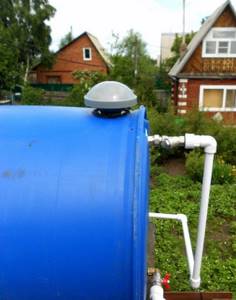
The project should indicate existing and planned underground communications, paths, buildings, and plantings, especially if a permanent summer water supply system is being installed. When installing a stationary summer water supply, trenches are prepared for laying pipes. The laying depth of pipes is usually 30-40 cm.
However, if the pipes lie under the beds, and there is a possibility of them being damaged by a shovel or cultivator, then the depth of the trench is increased to 50-70 cm. This is a labor-intensive process, but replacing broken pipes and eliminating leaks is even more difficult. Pipes reach the surface of the earth only in places where water is supplied.
When planning a permanent water supply, it is important to remember that all pipes in the trench are laid at a slope towards the connection to the water intake. A drain valve is installed at the very bottom of the pipeline. This will allow you to drain the water for the winter and avoid damage to the pipes. It is necessary to determine in advance the places for supplying water.
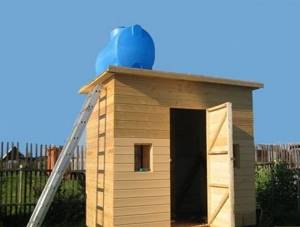
The number of consumption points depends on the location of the beds, greenhouse, summer shower, bathhouse, and swimming pool. In order not to carry the hose from place to place, it is wiser to remove the pipes at 5-10 points. Hose sections 3-5 m long are connected to such hydrants, which ensures watering of each individual zone. A bayonet mount for quick connection of a hose or an automatic spray system is installed at all consumption points.
Before cutting off hoses or sawing pipes, you should carefully measure the required length with a tape measure, mark them with a marker, and only then begin cutting. This approach, according to the principle of measure seven times and cut once, will save you from annoying mistakes and additional costs.
Elements of a water supply system from an autonomous source
In order to install a water supply system at your dacha with your own hands, you will need equipment, tools, and materials.
- Electric pump, manual (if necessary), hydraulic accumulator or pumping station.
- Relay, dry relay, winter, check valve, pressure gauges, filter or filter system.
- Boiler, instantaneous electric heater or gas water heater for hot water supply.
- Pipes, flexible hoses of various diameters.
- Clamp fittings, tees, couplings, gaskets.
- Shut-off valves, including for water collection points on the site.
- Fum tape, flax for sealing joints.
- Tools: for excavation work, electrical installation. Keys: gas, adjustable. Tape measure, level, hacksaw or pipe cutter, knife, welding machine for polypropylene pipes.
This is a basic set for water supply in a country house: it is impossible to foresee all situations.
What materials, devices and tools are required for arranging a summer water supply system?
To install a summer water supply at your summer cottage, you will need the following materials and tools:
- Pipes and hoses.
- Fittings and tees.
- Compression couplings with external thread (20; 1/2).
- Adjustable wrench, gas wrench, wrenches No. 17-24.
- A special cutter for plastic water pipes or a hacksaw for metal.
- Shovel.
- Scrap.
- Soldering iron. If you plan to connect pipes by welding, use a special electric soldering iron instead of fittings and a gas wrench. Soldering irons are inexpensive, and some hardware stores even rent them out.
- Ball valve 1/2.
- Compression angle 20 mm.
- Compression tee 20 mm.
- Saddle 63 (1/2).
- Fumnitka.
- Adjustable wrench, gas wrench and spanners No. 17-24.
- Sanding paper.
- Knife, tape measure, pencil.
Pipes
Pipes for assembling a summer water supply system on an average dacha plot of 10 acres are preferable to plastic or polyethylene (diameter 20-25 mm, length 100 m). Reliable uninterrupted water supply largely depends on the quality of the pipes. Green polypropylene pipes from Banninger with a diameter of 25 mm have proven themselves well. They are more expensive than traditional white pipes, but they are resistant to temperature changes and can withstand even frosts.
Hoses
Instead of pipes, you can use hoses.
Rubber hoses with thick walls reinforced with nylon fibers are stronger and more durable; they will reliably serve for 15 years.
Fittings and tees
The routing of summer water supply pipes is carried out using tees, and special fittings are best suited for connecting plastic pipes. Using fittings allows you to assemble a country water supply system in just one day. In this case, the joint is sealed, and if necessary, the structure can be easily disassembled.
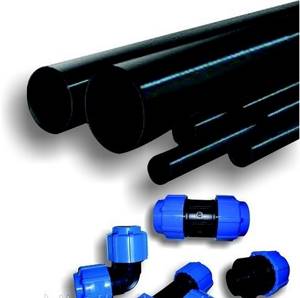
Construction of a water supply system from a well
The location of the well on the site is regulated by SNiP 30-02-97. In particular, the distance from residential buildings, sources of possible water pollution. The small size of summer cottages makes choosing a location a difficult task. To supply water from a remote well, you will need a powerful pump, a large number of pipes, and fittings. The winter system provides for insulation of the pipeline.
The ideal place for a well is under the house. But only with a shallow foundation. The minimum distance from the house is 3 meters. The distance to the septic tank is 30 m. You should pay attention to large trees: their roots will interfere. 4 meters in this case is optimal. The correct solution would be the order: first draw water into the house from the well, then place other objects on the site.
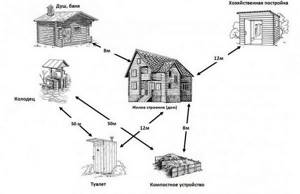
As a rule, the pump is placed directly in the well. To connect to the pipeline and supply cable, 2 holes are punched in the reinforced concrete rings at a freezing depth of +20 cm. After entering the communications, they are closed with a hydraulic seal.
The range of well pumps is quite large, but when installing year-round water intake, it is better to choose a well pump. Due to oil cooling and a stainless steel case, the service life of such a product is much longer. They have great power, which will allow you to pump water from a distant source.
To reduce the number of on-off cycles and compensate for water hammer, most pump models require the connection of a hydraulic accumulator. Preference should be given to stainless steel tanks: at a price of +20-30%, it will last much longer. Sooner or later, the rubber bulb in it will rupture, which will start the process of rusting of the ferrous metal.
Particular attention should be paid to pipes. The most commonly used are HDPE (low-density polyethylene) and PPR (polypropylene). There should be no scratches on the surface; there should be a blue stripe along the entire length (for cold drinking water). The wall thickness of the HDPE pipe is only 3 mm. Pipes with a wall of 2.4 mm are not suitable for water supply.
Year-round water supply
Most often, water is supplied from a well using a submersible pump. The pump power is selected depending on the depth of the well. For a depth of 10 m, “Aquarius” or “brook” is suitable. To draw water from a well, you will need a much more powerful pump.
When installing a year-round water supply in a country house, the pump is connected to a voltage source, and the cable and water supply are laid together in a single casing assembled from plastic sewer pipes. The casing serves to protect the water supply from mechanical damage and freezing.
The depth of the trench for laying the water supply must be below the freezing level of the soil. Digging such a trench is a labor-intensive task. You can make the task easier by digging a trench to a depth of 60 cm, and pouring a layer of insulation 20-30 cm thick on top of the pipe. Quite durable materials with low moisture absorption are used as insulation: foam chips, polyethylene, furnace slag, expanded clay .
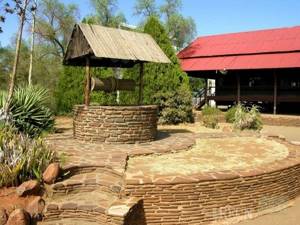
A pit of 70x70 cm and a depth of 1 m is dug near the well. The pit is used to connect the pump to the water supply, and, if necessary, quickly disconnect and remove the pump. The walls of the pit are lined with bricks or reinforced with boards with antiseptic impregnation. The bottom is filled with concrete mortar or covered with crushed stone and compacted. A water pipe with a “brush” for the hose connected to the pump, as well as an electrical cable, are brought into the pit and secured.
To prevent the water in the pump hose from freezing, the pit is insulated. A small drain hole with a diameter of about 1 mm is made in the lower part of the water supply system, thanks to which the water in the water supply system slowly flows into the pit and does not freeze in winter.
The disadvantage of this scheme is the constant humidity in the pit and insignificant loss of water.
To safely turn the pump on and off, install a waterproof socket or use a sealed contact connector.
In outdoor conditions, ordinary taps with faucets are most often installed, or even better, bronze or cast iron valves. It is undesirable to use ball valves; they quickly fail under the influence of precipitation and temperature fluctuations.
The most complex unit of a year-round water supply system is the “fontal” water distribution unit, located in an unheated room. Most often, special devices are used for such purposes - water dispensers. A significant disadvantage of the column is the high cost of equipment and the complexity of installation.
Hot water is comfortable
Hot water storage - boiler or instantaneous heater? It all depends on the number of people at the dacha and the length of their stay. For two or even three people visiting the dacha on weekends, a flow-through heater will be sufficient. It heats water instantly.
The electric water heater will allow you to use hot water a few hours after turning it on. The insulated tank maintains the water temperature for a long time after switching off. For short-term visits, such a schedule is inconvenient. A reasonable compromise is to have two sources of hot water and use them depending on the situation.
Installation and connection of heating devices is carried out according to the instructions supplied with them.
Installation of a water supply system
In such systems, only plastic pipes are used: polyethylene (HDPE) or polypropylene (PPR), metal-plastic (for wiring around the house). Metal pipes (with the exception of copper) are a thing of the past. Plastic is inert, does not corrode, and can withstand freezing of water. The inner surface is perfectly smooth, no silt or salts are deposited on it.
HDPE pipes are connected using plastic tightening fittings. There are fittings for converting from HDPE to metal. The price of the connecting elements is quite high, but additional equipment (you can also chamfer the ends of the pipes manually) is not required.
Density of pipe material: 63, 80 and 100. The latter is the most reliable. To work under pressure, you should choose brands SL (up to 4.5) and C (up to 8 atmospheres). HDPE is exposed to ultraviolet radiation from the sun, so trench installation is required.
Polypropylene pipes are connected by welding. This requires a special tool; it is inconvenient to work with on the site. It is not advisable to buy it. Almost everywhere it is possible to rent a welding machine in stores that sell such pipes. Fittings are also not cheap. PPR does not bend: a lot of connecting elements will be required.
Step-by-step instructions on how to bring water into the house look like this.
- Construction of trenches, preparation of insulation for pipes.
- Power supply.
- Installation of a pump or pumping station, if necessary, install pressure control relays, pressure gauges, filters and inlet pipe.
- In the lowest place, drain the entire system.
- Installation of pipelines with outlets for water collection points.
- Checking the operation of the external system, eliminating leaks.
- Installation of internal water supply network.
- Installation of a water heater.
During the work process, you should constantly check the project.
Which pipes to choose for water supply in the country
Just a decade and a half ago, no questions arose: there was no alternative to steel pipes. Today, metal is almost no longer used for country water supply: it is expensive, welding is required for installation, and modern pipes rust quickly. There is a much more practical alternative - plastic pipes. They are the best solution for country water supply: they definitely do not rust, some are also not afraid of frost. But plastic is different, as are the products made from it.
HDPE pipes
Most often, HDPE pipes - low-density polyethylene - are used for water supply in the country. They are attractive because they can be assembled without any additional devices. Fittings for assembling HDPE water pipes are threaded and are simply tightened by hand.
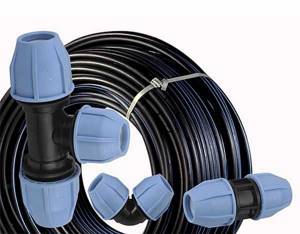
HDPE pipes for water supply systems are produced in coils or in sections (depending on the diameter)
Why are HDPE polyethylene pipes so good that they have almost replaced metal pipes? In addition to convenient installation, there are a number of advantages:
- If the operating rules are followed, the service life is 50 years. This figure has not yet been verified, but it is impressive.
- They do not rot, do not rust, and are resistant to chemical environments.
- Can be operated at temperatures down to -60°C.
- When the water in them freezes, they do not burst - they stretch, then after thawing they return to their previous size.
- Their inner surface is perfectly smooth. For water supply, this is important for two reasons: there is less pressure loss during transportation and deposits do not accumulate on the walls, they are simply carried away by the flow.
- With their help, it is very easy to make water supply in your dacha with your own hands, as well as make changes later.
- HDPE pipes can be used to install summer and winter water supply systems.
- Convenient assembly methods: welding or compression (threaded) fittings.
Water – all year round
Winter and summer water supply systems at the dacha are identical in design, differing only in the depth of the pipelines, their insulation, as well as pumping equipment. The pipes are laid with a slight slope (2-3°) towards the source or main line: water will not stand in the pipes.
It is necessary to select a location for the suction pump or pumping station. Standard solution: build a caisson - a pit next to the well. But the humidity in it will be increased. If possible, the equipment should be installed in a house or outbuilding.
Installation of external water supply network
Installing an autonomous water supply for a private house with your own hands begins with digging a trench from a well or borehole to entering it into the building. Ideally, the depth of the pipeline should be 30 cm below the soil freezing line. The trench is dug 100 mm deeper than this mark in order to create a sand cushion.
When digging and laying pipes, it is necessary to maintain a slope of the water main towards the well of 3-5 mm per 1 m of length (what is a heating cable for a water supply system). It serves to empty the pipeline.
If it is laid above the standard depth, then insulation is performed with half-cylinders of polystyrene foam or expanded polystyrene with a thickness of 40-60 mm (how to insulate water supply pipes in a private house). You should not use mineral wool in the ground; it will become saturated with moisture and cease to perform its functions.
